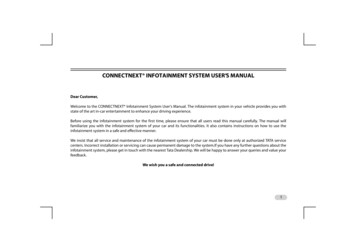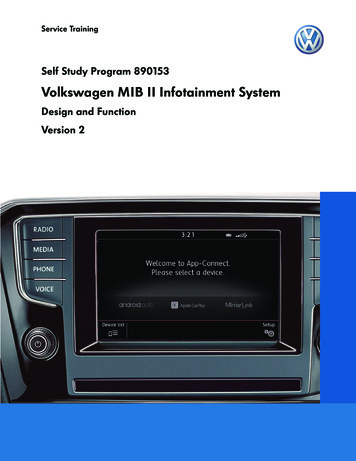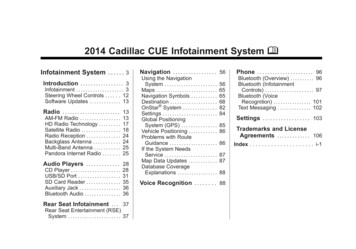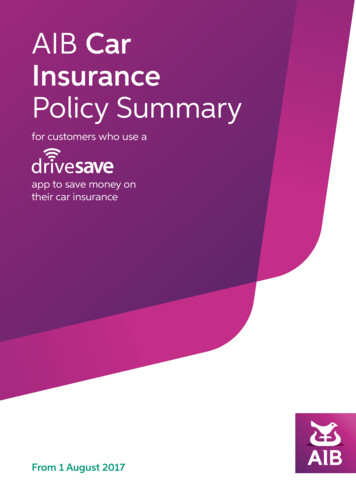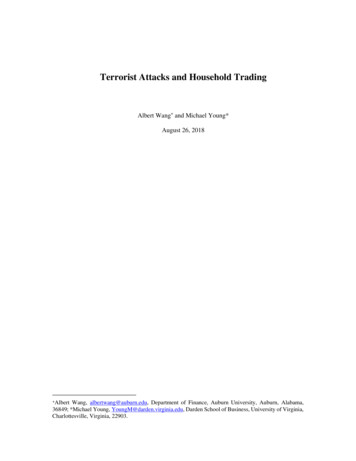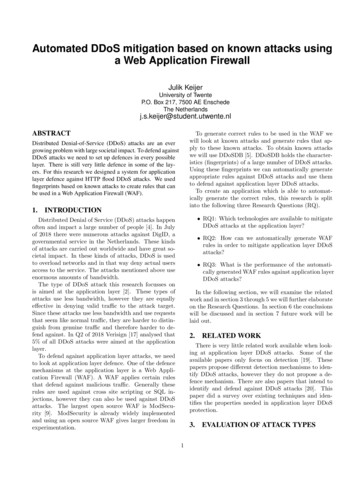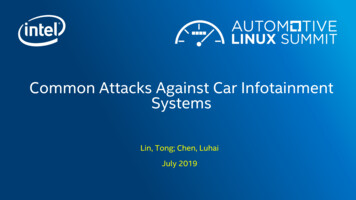
Transcription
Common Attacks Against Car InfotainmentSystemsLin, Tong; Chen, LuhaiJuly 2019
Agenda Background information Attack surfaces and related hacking incidents Possible mitigations Practices for automotive security testing Conclusion2
What is IVI? In-vehicle infotainment. A combination of in-vehicle systems that include both hardware andsoftware. Deliver information and entertainment to the driver and the passengers. Usually isolated from vehicle safety critical components through gateway.IVI is becoming more and more important with thegrowing demand for smart vehicles.3
IVI systems owned by automakers4
Top key players5
Key features of IVI system Multimedia play (audio and video) Hands-free phone call Satellite navigation and traffic condition update Social networking Interactive voice recognition services Most hacked cars are the ones with most features!!!6
Back to the topic Scope Focus on attacks against the IVI system. External diagnostic interface (OBD-II) is also included. No CAN bus hacking. The hacking incidents mentioned in the slides have already beenmitigated, although some of the details are not disclosed.7
Agenda Background information Attack surfaces and related hacking incidents Possible mitigations Practices for automotive security testing Conclusion8
Security without visibility Poor attack visibility is a major threat to automotive securityYou can’t protect what you can’t UPp3Tc4A32S0WXJ0pWP7g.jpeg9
Quick glimpseAttacksurfacesUSB nge10
USB port Media playback via USB Firmware/software updates via USB USB-to-Ethernet Serve as debug interfaces but also create an extra interface Use port scanning to detect vulnerable internal networking services Run shell scripts or install unauthorized software via USB DMA attack against USB 3.x11
Malware injection via USB Researchers from Zingbox found a way to hack into IVI system with amaliciously crafted USB device. The attack could be done via social engineering tricks. Malware installed in the IVI system can leverage SMS service on the paired driver’s phone to access personalinformation, intercept banking authentication pins, or even block phone calls. be commanded remotely through SMS messages and put the IVI system intoan unusable Threat-Cars-Drivers12
Firmware updates via USB A security researcher could install malicious Subaru StarLink head unitfirmware via USB and gain persistent root code execution by exploiting avulnerability (CVE-2018-18203) in the update k-research/blob/master/doc/README.md#conclusion13
Multimedia playback The most common entry point to gain access to the IVI. Examples old-fashioned CD-ROM/DVD-ROM, local multimedia file stored in USB sticks/SD card new-fashioned Audio over Bluetooth Apple Carplay/Google Android Auto UPnP (Universal Plug and Play) Specially prepared media files can be used to tamper media engineservices, Bluetooth, and Wi-Fi stacks.14
Use Trojan CD to hack car By adding extra code to a digital music file, researchers were able to turna song burned to CD into a Trojan horse. When played on the car's stereo, this song could alter the firmware of thecar's stereo system, giving attackers an entry point to change othercomponents on the car. This type of attack could be spread on file-sharing networks withoutarousing /hackers can take full control of car os/15
Applications Expand the functionality of the native HMI. Mainly consists of two parts Apps that are directly installed into the IVI system Apps installed in consumer's smartphone and can remotely connected to theIVI system Cloud security Some apps are connected to cloud for data exchange.16
Onboard browser hacked at Pwn2Own Researchers from Fluoroacetate hacked the Tesla Model 3 car via itsonboard browser. They used a JIT bug in the browser renderer process toexecute code on the car's firmware and show a message on its IVI ked-at-pwn2own-contest/17
Vulnerability in connected vehicle app A MITM attack may intercept the encryptedconnection between Mercedes me app and server. CWE-300 518
Short-range wireless communication Wi-Fi or Bluetooth Packet sniffing Jamming MITM Protocol-related exploits DSRC (Dedicated Short Range Communications) vehicle-to-everything (V2X) communications19
CarsBlues Found by Privacy4Cars. Exploit IVI systems via the Bluetooth protocol. The attacker can access stored contacts, call logs, text logs, and in somecases even full text messages without the vehicle’s owner/user beingaware - and without the user’s mobile device being connected to be-hacked/default.aspx20
Exploitable Wi-Fi connection vulnerabilities Vulnerabilities exist in MIBmanufactured by Harman. A quick port scan shows thatthere is a telnet service listening,but without valid credentials. The researchers finally have remote code execution by exploiting thevulnerable internet service on MMX.21
Exploitable Wi-Fi connection vulnerabilities Another component RCC(sharing filesystem with MMX,using Qnet) also has a telnetservice running. Finally control RCC throughrewriting the original telnetbinary on MMX.https://www.computest.nl/documents/9/The Connected Car. Research Rapport Computest april 2018.pdf22
Long-range wireless communication cellular radio (3G/4G/5G) emergency call, anti-theft tracking, online weather/news GPS Usually be used to provide traffic information for some navigation serviceswith RDS (Radio Data System) and TMC (Traffic Message Channel) Attack types GPS Tracking Apps GPS spoofing23
GPS Tracking Apps Default user account passwordfound in GPS tracker apps (ProTrackand iTrack) by reverse engineering. After breaking into these accounts,the attacker could monitor thelocations of vehicles and even turnoff the engines of vehicles that aretraveling 12 miles per hour or slower.https://www.vice.com/en gps-tracking-apps24
GPS spoofing An attacker can send sat-nav-guided vehicles into oncoming traffic (suchas a one-way road) by GPS spoofing. A low-cost portable GPS s.pdf25
External diagnostic interface (OBD-II) On-Board Diagnostics (OBD) is vehicle’s built-in self-diagnostic system. OBD-II, an evolutionary standard introduced in the mid-’90s. Initial physical access is needed.26
Bluetooth diagnostic moduleTesla’s diagnostics connectorOBD-II Bluetooth moduleSome diagnostic information Will lead to a lot of error messages,even rear motors going offline andthen lost all power by log/tesla-killer-thefuzzed-and-the-furious/27
Exploit techniques behind IVI hacking Malware injection Tricking users into installing by USB Clicking on unknown links or installing fake software from untrusted sources Utilizing the design flaw in the upgrade mechanism Security vulnerabilities exploitation Existing exploits in operating systems or applications Compromise insecure networks MITM attack28
Exploit techniques behind IVI hacking Reverse engineering Sensitive data disclosure PII (personally identifiable information), VIN (vehicle identificationnumber) cryptographic keys Discover key APIs and even tampering code Firmware/software can be got by online downloads, after-sales support orinsecure OTA Spoofing DoS attacks by fuzzing29
Agenda Background information Attack surfaces and related hacking incidents Possible mitigations Practices for automotive security testing Conclusion30
Not just a jokeTrue wisdom is, ultimately, not in the knowing, but in the doing.https://imgs.xkcd.com/comics/security advice.png31
For USB port Check the file system of a USB stick and only supported file systems canbe allowed to mount. Enhance security permission with read-only, nodev, nosuid and noexecoptions. Minimize USB configuration to make sure only necessary USB deviceclasses are enabled.32
For update mechanisms Always sign or encrypt update packages. Ensure the upgrade procedure is to be authenticated. Allow secure boot for integrity validation. Secure key storage. Rescue mode to fall back in case of update failure.33
For onboard applications Can only be installed from the official/specific sources. Divide different security domains for application management and applystrict access model (RBAC, PBAC, ). Isolated “high-risk” applications into containers/VMs. An update mechanism should be used that allows deployment of securityupdates.34
For remotely connected applications Secure connections from the backend cloud service to theapplication/vehicle endpoint. Improve the authentication mechanism to defend against man-in-themiddle attacks. Weak password detection.35
For wireless communication All wireless protocols need to be properly configured. All unused Bluetooth profiles should be disabled. Restrict network routing to pre-defined normal behavior, block and alertsecurity systems about any invalid attempts.36
For GPS spoofing SAASM (Selective Availability Anti-Spoofing Module) But SAASM-enabled GPS receiver is only available to government or militaryauthorized users. Use receiver that can track multiple GNSS signals (such as GPS, GLONASS,Galileo, and BeiDou) simultaneously.37
Agenda Background information Attack surfaces and related hacking incidents Possible mitigations Practices for automotive security testing Conclusion38
Before this part begins The practices to share are from our team’s experience of Celadon project(https://01.org/projectceladon/). Certainly, they also can be applied to benefit other projects.39
Break large overall tests into small tasks Figure out different components/interfaces and test separately fordifferent parts. Break down any large multi-action tests into smaller, more specific singleaction tests.40
Discover vulnerabilities in early stage Manual review: Forward review of enumerated list of entrypoint functions. Pick a feature and find common weaknesses across different implementations. Find variants of known issues. Fuzzing: Corpus creation Parameter optimization Coverage feedback Crash analysis41
Select the right tools For static code analysis/vulnerability scanning Klocwork, Coverity, CAST, cve-bin-tool, BDBA, WhiteSource For USB USB Rubber Ducky, Facedancer21, USB Kill, umap from NCC Group For wireless communication HackRF, BladeRF, Ubertooth One, RF Signal Analyzer Wireshark, Burp Suite, Fiddler For general fuzzing Syzkaller42
Create custom test for specific attack scenarios DMA attack Side channel attack43
Continuous Security Testing tools automation. DevSecOps Solve the bottleneck effect of older security models on the modern continuousdelivery pipeline. Avoid last-minute delays.44
Agenda Background information Attack surfaces and related hacking incidents Possible mitigations Practices for automotive security testing Conclusion45
Conclusion You can’t have safety without security. The quality of materials used andthe security of the embedded software is equally important. It’s important to know your enemy. Defense is more difficult because itrequires consideration of various attack surfaces and means. Deliver software with security built into it, not on or around it. Thesecurity development lifecycle (SDL) will help ensure that security andprivacy tasks integrated into each stage of development as part of aseamless process.46
Thanks!Q&A47
Notices and DisclaimersNo license (express or implied, by estoppel or otherwise) to any intellectualproperty rights is granted by this document.Intel disclaims all express and implied warranties, including withoutlimitation, the implied warranties of merchantability, fitness for a particularpurpose, and non-infringement, as well as any warranty arising from courseof performance, course of dealing, or usage in trade.Intel and the Intel logo are trademarks of Intel Corporation or itssubsidiaries in the U.S. and/or other countries.*Other names and brands may be claimed as the property of others 2019 Intel Corporation48
3 What is IVI? In-vehicle infotainment. A combination of in-vehicle systems that include both hardware and software. Deliver information and entertainment to the driver and the passengers.

